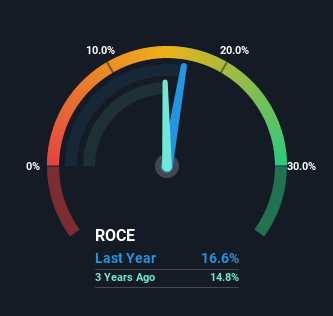[ad_1]
Did you know there are some financial metrics that can provide clues of a potential multi-bagger? In a perfect world, we’d like to see a company investing more capital into its business and ideally the returns earned from that capital are also increasing. This shows us that it’s a compounding machine, able to continually reinvest its earnings back into the business and generate higher returns. With that in mind, we’ve noticed some promising trends at PUMA (ETR:PUM) so let’s look a bit deeper.
Understanding Return On Capital Employed (ROCE)
For those that aren’t sure what ROCE is, it measures the amount of pre-tax profits a company can generate from the capital employed in its business. The formula for this calculation on PUMA is:
Return on Capital Employed = Earnings Before Interest and Tax (EBIT) ÷ (Total Assets – Current Liabilities)
0.17 = €652m ÷ (€6.6b – €2.7b) (Based on the trailing twelve months to June 2022).
Therefore, PUMA has an ROCE of 17%. In absolute terms, that’s a satisfactory return, but compared to the Luxury industry average of 4.9% it’s much better.
See our latest analysis for PUMA

In the above chart we have measured PUMA’s prior ROCE against its prior performance, but the future is arguably more important. If you’re interested, you can view the analysts predictions in our free report on analyst forecasts for the company.
What The Trend Of ROCE Can Tell Us
The trends we’ve noticed at PUMA are quite reassuring. Over the last five years, returns on capital employed have risen substantially to 17%. The company is effectively making more money per dollar of capital used, and it’s worth noting that the amount of capital has increased too, by 118%. The increasing returns on a growing amount of capital is common amongst multi-baggers and that’s why we’re impressed.
Another thing to note, PUMA has a high ratio of current liabilities to total assets of 41%. This effectively means that suppliers (or short-term creditors) are funding a large portion of the business, so just be aware that this can introduce some elements of risk. Ideally we’d like to see this reduce as that would mean fewer obligations bearing risks.
The Bottom Line On PUMA’s ROCE
A company that is growing its returns on capital and can consistently reinvest in itself is a highly sought after trait, and that’s what PUMA has. And with a respectable 92% awarded to those who held the stock over the last five years, you could argue that these developments are starting to get the attention they deserve. With that being said, we still think the promising fundamentals mean the company deserves some further due diligence.
While PUMA looks impressive, no company is worth an infinite price. The intrinsic value infographic in our free research report helps visualize whether PUM is currently trading for a fair price.
While PUMA may not currently earn the highest returns, we’ve compiled a list of companies that currently earn more than 25% return on equity. Check out this free list here.
Have feedback on this article? Concerned about the content? Get in touch with us directly. Alternatively, email editorial-team (at) simplywallst.com.
This article by Simply Wall St is general in nature. We provide commentary based on historical data and analyst forecasts only using an unbiased methodology and our articles are not intended to be financial advice. It does not constitute a recommendation to buy or sell any stock, and does not take account of your objectives, or your financial situation. We aim to bring you long-term focused analysis driven by fundamental data. Note that our analysis may not factor in the latest price-sensitive company announcements or qualitative material. Simply Wall St has no position in any stocks mentioned.
Discounted cash flow calculation for every stock
Simply Wall St does a detailed discounted cash flow calculation every 6 hours for every stock on the market, so if you want to find the intrinsic value of any company just search here. It’s FREE.
[ad_2]
Source link








